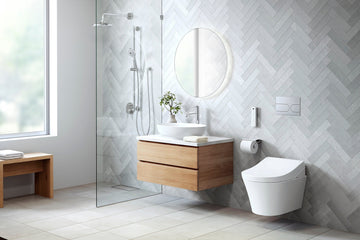As the global population ages, the need for elderly friendly toilet designs becomes increasingly important. These designs not only enhance the safety and comfort of older adults but also enable them to maintain their independence. In this article, we will explore the key elements that make up an elderly-friendly bathroom and the latest design innovations that cater to this demographic.

The Importance of Safe and Accessible Bathrooms
Bathrooms can be hazardous for the elderly due to factors like slippery surfaces and limited mobility. Thus, incorporating elderly-friendly features is crucial to prevent accidents and ensure a safe environment. These features often include non-slip flooring, grab bars, and adjustable-height elements.
Understanding the significance of these elements, many companies are now focusing on creating accessible toilet designs that cater specifically to the needs of older adults. This trend is evident in their emphasis on comfort, ease of use, and safety.
Key Features of Elderly Friendly Toilet Designs
Comfort-Height Toilets
One of the primary features of elderly-friendly toilets is the comfort-height design. These toilets are taller than standard models, making it easier for seniors to sit down and stand up without straining their joints. This design not only enhances comfort but also reduces the risk of falls.
Grab Bars and Handrails
Installing grab bars and handrails in strategic locations within the bathroom can significantly enhance safety. These supports help older adults maintain balance and prevent falls while moving around the bathroom. It's essential to ensure that these bars are installed at the correct height and are securely attached.
Non-Slip Flooring
Slippery surfaces are a common cause of accidents in the bathroom. To mitigate this risk, using non-slip flooring materials is highly recommended. These materials provide better traction, even when wet, reducing the likelihood of slips and falls.
Advanced Bidet Systems
Modern toilet designs often incorporate advanced bidet systems that offer cleansing without the need for manual wiping. This feature is particularly beneficial for individuals with mobility issues, as it promotes hygiene and reduces the need for assistance. For more on bidet systems, check out this article.
Latest Innovations in Elderly Friendly Toilet Designs
With technological advancements, there are numerous innovations aimed at enhancing the bathroom experience for older adults. These innovations focus on improving accessibility, comfort, and overall user experience.
Smart Toilets
Smart toilets are becoming increasingly popular in elderly-friendly bathroom designs. These toilets come with automated features such as self-cleaning bowls, automatic flushing, and heated seats. Such functionalities not only add convenience but also aid those with limited mobility. Learn more about accessible smart toilets.
Sensor-Activated Features
Sensor-activated technology has found its way into modern toilet designs, offering touchless flushing, lighting, and even faucet operation. This technology reduces the need for physical interaction, making it ideal for older adults who may have dexterity issues.
To explore some of the latest innovations in public toilet technology, you can visit Tomorrow City.
Design Tips for an Elderly Friendly Bathroom
When designing a bathroom for the elderly, it's not just about the toilet. The entire space should be considered to maximize safety and accessibility.
Proper Lighting
Adequate lighting is essential in an elderly-friendly bathroom. Ensure that the bathroom is well-lit, with bright and evenly distributed lighting to help avoid accidents. Motion-activated lights can also be a useful addition, providing visibility without requiring manual switches.
Accessible Storage
Storage areas should be easily accessible. Avoid high shelves or deep cabinets that require bending or reaching. Instead, opt for pull-out drawers and open shelving that keeps toiletries within easy reach.
Walk-In Showers
Walk-in showers with low or no thresholds are a safer option than traditional tubs. These designs facilitate easy entry and exit, reducing the risk of tripping. Additionally, including a shower seat and handheld showerhead can provide extra comfort and convenience.
Conclusion
Incorporating elderly friendly toilet designs into homes and public spaces is more than just a trendit's a necessity for ensuring the safety, comfort, and dignity of our aging population. By focusing on accessibility, innovation, and thoughtful design, we can create environments that cater to the needs of older adults, allowing them to live independently and comfortably.

FAQs
What are the benefits of comfort-height toilets?
Comfort-height toilets are beneficial as they reduce the strain on the knees and joints, making it easier for seniors to sit and stand. This design helps prevent falls and enhances overall comfort.
How do smart toilets aid the elderly?
Smart toilets offer automated features like self-cleaning, touchless flushing, and heated seats, making them convenient for seniors. These features reduce the need for physical interaction and assist those with mobility issues.
Why is non-slip flooring important in bathrooms?
Non-slip flooring is crucial in preventing slips and falls, especially in wet environments like bathrooms. It provides better traction, ensuring safety for elderly individuals.
This article contains affiliate links. We may earn a commission at no extra cost to you.






